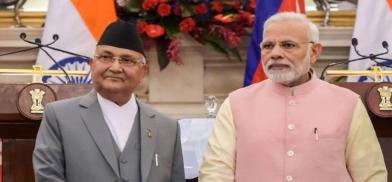Souring India-Nepal ties
China has made all-out efforts to draw Nepal into its strategic sphere and has stoked anti-India feelings, writes Lt Gen P. C. Katoch (retd) for South Asia Monitor

On Saturday (June 13) Nepal’s Parliament passed a new map that shows Lipulekh, Kalapani and Limpiyadhura areas (totaling about 370 sq km) in its territory. This has been rejected by India since these areas are in Pithoragarh district of Uttrakhand and have been under India’s control over the past six decades. Persons in these areas are Indian citizens, they pay taxes in India and vote in Indian elections. India also has posts in Kalapani since 1962. Nepal claims these areas were given to Nepal by the 1816 Treaty of Saguali between British India and Nepal.
The 1816 Treaty of Saguali gave Nepal all territory east of Kali river. Descending from the watershed, Kali river consists of two channels - western channel, Kuthi Yankti, is the main channel, which originates near Lampiyadhura and joins the other channel at Gunji. This channel originates from Lipulekh. Prior to 1860, the Kuthi Yankti was supposedly the boundary with Nepal - hence the controversy.
India’s map showing the reorganized state of Jammu & Kashmir of October 2019 had drawn adverse remarks by China-Pakistan and irked Nepal. Recently on May 8, India’s Defence Minister Rajnath Singh inaugurated the traditional 75 km trekking route, made motorable to Lipulekh Pass, on the India-Tibet border for easing the Kailash-Mansarovar Hindu pilgrimage. Nepal called this violation of its sovereignty, though it merits notice that the road is on the west bank of the Kali riiver which falls in India.
Chinese fingerprints?
Nepal raised border issues in the past but never made such a song and dance of it till the inauguration of the above-mentioned road. Ironically, the India-Nepal border is not fully settled, unlike the resolution of the India-Bangladesh border that even involved an island.
Instead of discussing the border issue with India first, Nepal has formalized its new map. Nepal is now asking for foreign secretary-level talks but India says trust must be established first. Coinciding with the India-China standoff in Ladakh, Nepal’s action has Chinese fingerprints, though Nepal denies it.
Beijing has considerable influence over the two major communist parties in Nepal - Unified Marxist-Leninist and Communist Party of Nepal (Maoist Centre). Earlier Nepal Prime Minister K P Sharma Oli was under domestic political pressure because he had to withdraw two ordinances he wanted passed due to stiff opposition. But pushing through the new map supported by the Nepali Congress, Oli is firmly back in command and is making statements adverse to India.
Nepal has commenced deploying armed police in its posts along the border with India. It being an open border, there is free movement to meet relatives on both sides. In a recent incident, Nepalese police opened fire on a group of Indians killing one and injuring two inside Nepal. However, this has been described as a 'local' event.
The Madhesi factor
Concurrent to Nepal’s new map, leaders of Nepal’s considerable Madhesi population (plains people, many of whom are of Indian origin) have revived their demand seeking constitutional amendment for equal opportunity and representation in government. Nepal witnessed three Madhesi movements in 2007, 2008 and 2015.
The last one in 2015-2016 saw considerable violence due to the strife between Kathmandu and the Terai region which hosts about half the Nepalese population. Nepal blamed India for blockading the India-Nepal border that caused considerable hardships, although Prime Minister Narendra Modi, the first Indian Prime Minister to visit Nepal in 17 years in 2014, had stated that India would treat Nepal as an integrated whole of both parts - mountain and plains.
Whether Oli will agree to the demands of Madhesis is questionable. But if not met, it can trigger another wave of Madhesi agitation, for which Oli will likely blame India. Instability in the Terai region which borders India will have cross-border impact also.
China has made all-out efforts to draw Nepal into its strategic sphere and has stoked anti-India feelings. Beijing's aggressive stance after the release of the virus from Wuhan and the current impasse at the Line of Actual Control (LAC) can influence Nepal’s behavior towards India.
( The author is an Indian Army veteran. The views expressed are personal. He can be contacted at prakashkatoch7@gmail.com)









Post a Comment